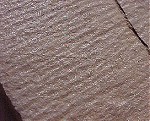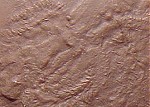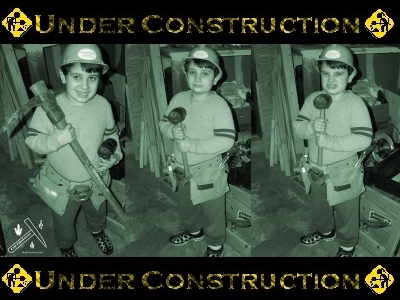Gettysburg Formation (MD) - All footprints shown here are from Maryland, and are from the late Triassic, Gettysburg Formation, Frederick County, MD. Typical ichnotaxon list: Rhynchosauroides brunswickii and others.
(lepidosauromorphs)

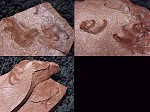
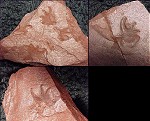
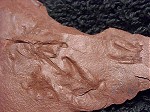
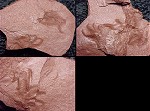

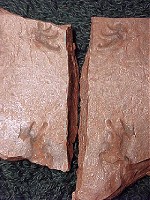

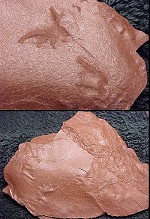
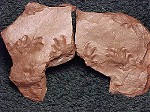
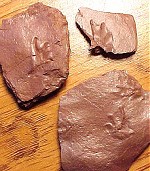

| Rhynchosauroides brunswickii tracks being recovered predominantly represent the hind feet and/or claws of the reptile. The animals producing these tracks were wading/swimming in shallow water, thus the tracks of the front feet and tail drags are almost unknown from this layer. Even the impressions of the full foot are scarce because these terrestrial yet water-loving reptiles were pushing off the bottom more often than not, leaving the imprints only of the claws. | |
| FIRST ROW: |
1) Three slabs. Upper left slab about 1" by 1" at widest points. Upper right slab 2" by 1 7/8" at widest ponts. Lower left slab 1.5" by 1 1/8" at widest points. More complete individual tracks average up to 1/2". 2) Three slabs. Upper left - Nice multiple w/couple of more partials on reverse side. Triangular-shaped slab about 1.75" by 1.75". Upper right - Print a little over 3/8" on slab 1" by 1.5" by 2" by 1.75". Claw marks on reverse. Lower right - Print a little over 1/4" on slab about 1" by 1 3/4". This is a positive underprint. There is a matching imprint on the reverse side with a couple of additional light partial prints. 3) Prints and claw scrapings. Slab is roughly 3" by 1.5" at widest points. For print scale, nicer print (in center of photo) is over 3/8". 4) Three slabs. Upper left slab 1.5" by 1". Upper right slab 1.75" by 1.75" at widest points. Lower left slab 1.3" by 1". 5) Matching positive and negative slabs, 1.5" by 1" and 1.5" by 1.75". For track scale, the top track is almost 1/2" across. |
| SECOND ROW: |
1) Matched positive and negative. For scale, top track is a little over 1/4". Second partial track a little bigger. One slab about 1.5" by 1.25" and matching halve 2" by 1" at widest points. 2) Matched positive and negative. Nice single track about 1/2" long on matched slabs about 2" by 2" plus. 3) Slab 3 1/2" by 2 1/4" at widest points. 4) Matched negative and positive. Slabs about 2" by 1 1/4" at widest points. 5) Three slabs. For scale, largest slab of the three is about 1 3/4" by 1 1/4". The largest has tracks on both sides. Best side shown. The smallest slab has a footprint pressed through. The underprint is on the under side. |
| THIRD ROW: |
1) Matched positive and negative. For scale, track is about 1/2" from toe to "heel". Matching slabs are about 2" by 3/4" at widest. 2) . 3) . 4) . 5) . |
(ripples, desiccation cracks, etc)
